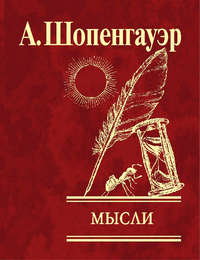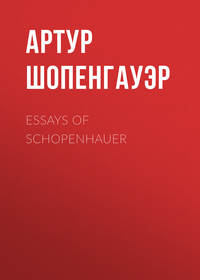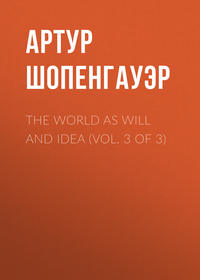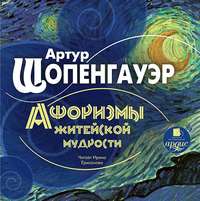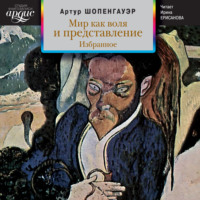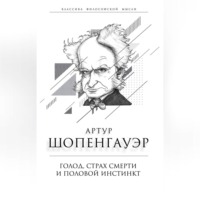 полная версия
полная версияThe World as Will and Idea (Vol. 2 of 3)
Chapter IX.21 On Logic In General
Logic, Dialectic, and Rhetoric go together, because they make up the whole of a technic of reason, and under this title they ought also to be taught – Logic as the technic of our own thinking, Dialectic of disputing with others, and Rhetoric of speaking to many (concionatio); thus corresponding to the singular, dual, and plural, and to the monologue, the dialogue, and the panegyric.
Under Dialectic I understand, in agreement with Aristotle (Metaph., iii. 2, and Analyt. Post., i. 11), the art of conversation directed to the mutual investigation of truth, especially philosophical truth. But a conversation of this kind necessarily passes more or less into controversy; therefore dialectic may also be explained as the art of disputation. We have examples and patterns of dialectic in the Platonic dialogues; but for the special theory of it, thus for the technical rules of disputation, eristics, very little has hitherto been accomplished. I have worked out an attempt of the kind, and given an example of it, in the second volume of the “Parerga,” therefore I shall pass over the exposition of this science altogether here.
In Rhetoric the rhetorical figures are very much what the syllogistic figures are in Logic; at all events they are worth considering. In Aristotle's time they seem to have not yet become the object of theoretical investigation, for he does not treat of them in any of his rhetorics, and in this reference we are referred to Rutilius Lupus, the epitomiser of a later Gorgias.
All the three sciences have this in common, that without having learned them we follow their rules, which indeed are themselves first abstracted from this natural employment of them. Therefore, although they are of great theoretical interest, they are of little practical use; partly because, though they certainly give the rule, they do not give the case of its application; partly because in practice there is generally no time to recollect the rules. Thus they teach only what every one already knows and practises of his own accord; but yet the abstract knowledge of this is interesting and important. Logic will not easily have a practical value, at least for our own thinking. For the errors of our own reasoning scarcely ever lie in the inferences nor otherwise in the form, but in the judgments, thus in the matter of thought. In controversy, on the other hand, we can sometimes derive some practical use from logic, by taking the more or less intentionally deceptive argument of our opponent, which he advances under the garb and cover of continuous speech, and referring it to the strict form of regular syllogisms, and thus convicting it of logical errors; for example, simple conversion of universal affirmative judgments, syllogisms with four terms, inferences from the consequent to the reason, syllogisms in the second figure with merely affirmative premisses, and many such.
It seems to me that the doctrine of the laws of thought might be simplified if we were only to set up two, the law of excluded middle and that of sufficient reason. The former thus: “Every predicate can either be affirmed or denied of every subject.” Here it is already contained in the “either, or” that both cannot occur at once, and consequently just what is expressed by the laws of identity and contradiction. Thus these would be added as corollaries of that principle which really says that every two concept-spheres must be thought either as united or as separated, but never as both at once; and therefore, even although words are brought together which express the latter, these words assert a process of thought which cannot be carried out. The consciousness of this infeasibility is the feeling of contradiction. The second law of thought, the principle of sufficient reason, would affirm that the above attributing or denying must be determined by something different from the judgment itself, which may be a (pure or empirical) perception, or merely another judgment. This other and different thing is then called the ground or reason of the judgment. So far as a judgment satisfies the first law of thought, it is thinkable; so far as it satisfies the second, it is true, or at least in the case in which the ground of a judgment is only another judgment it is logically or formally true. But, finally, material or absolute truth is always the relation between a judgment and a perception, thus between the abstract and the concrete or perceptible idea. This is either an immediate relation or it is brought about by means of other judgments, i. e., through other abstract ideas. From this it is easy to see that one truth can never overthrow another, but all must ultimately agree; because in the concrete or perceptible, which is their common foundation, no contradiction is possible. Therefore no truth has anything to fear from other truths. Illusion and error have to fear every truth, because through the logical connection of all truths even the most distant must some time strike its blow at every error. This second law of thought is therefore the connecting link between logic and what is no longer logic, but the matter of thought. Consequently the agreement of the conceptions, thus of the abstract idea with what is given in the perceptible idea, is, on the side of the object truth, and on the side of the subject knowledge.
To express the union or separation of two concept-spheres referred to above is the work of the copula, “is – is not.” Through this every verb can be expressed by means of its participle. Therefore all judging consists in the use of a verb, and vice versâ. Accordingly the significance of the copula is that the predicate is to be thought in the subject, nothing more. Now, consider what the content of the infinitive of the copula “to be” amounts to. But this is a principal theme of the professors of philosophy of the present time. However, we must not be too strict with them; most of them wish to express by it nothing but material things, the corporeal world, to which, as perfectly innocent realists at the bottom of their hearts, they attribute the highest reality. To speak, however, of the bodies so directly appears to them too vulgar; and therefore they say “being,” which they think sounds better, and think in connection with it the tables and chairs standing before them.
“For, because, why, therefore, thus, since, although, indeed, yet, but, if, then, either, or,” and more like these, are properly logical particles, for their only end is to express the form of the thought processes. They are therefore a valuable possession of a language, and do not belong to all in equal numbers. Thus “zwar” (the contracted “es ist wahr”) seems to belong exclusively to the German language. It is always connected with an “aber” which follows or is added in thought, as “if” is connected with “then.”
The logical rule that, as regards quantity, singular judgments, that is, judgments which have a singular conception (notio singularis) for their subject, are to be treated as universal judgments, depends upon the circumstance that they are in fact universal judgments, which have merely the peculiarity that their subject is a conception which can only be supported by a single real object, and therefore only contains a single real object under it; as when the conception is denoted by a proper name. This, however, has really only to be considered when we proceed from the abstract idea to the concrete or perceptible, thus seek to realise the conceptions. In thinking itself, in operating with judgments, this makes no difference, simply because between singular and universal conceptions there is no logical difference. “Immanuel Kant” signifies logically, “all Immanuel Kant.” Accordingly the quantity of judgments is really only of two kinds – universal and particular. An individual idea cannot be the subject of a judgment, because it is not an abstraction, it is not something thought, but something perceived. Every conception, on the other hand, is essentially universal, and every judgment must have a conception as its subject.
The difference between particular judgments (propositiones particulares) and universal judgments often depends merely on the external and contingent circumstance that the language has no word to express by itself the part that is here to be separated from the general conception which forms the subject of such a judgment. If there were such a word many a particular judgment would be universal. For example, the particular judgment, “Some trees bear gall-nuts,” becomes a universal judgment, because for this part of the conception, “tree,” we have a special word, “All oaks bear gall-nuts.” In the same way is the judgment, “Some men are black,” related to the judgment, “All negroes are black.” Or else this difference depends upon the fact that in the mind of him who judges the conception which he makes the subject of the particular judgment has not become clearly separated from the general conception as a part of which he defines it; otherwise he could have expressed a universal instead of a particular judgment. For example, instead of the judgment, “Some ruminants have upper incisors,” this, “All unhorned ruminants have upper incisors.”
The hypothetical and disjunctive judgments are assertions as to the relation of two (in the case of the disjunctive judgment even several) categorical judgments to each other. The hypothetical judgment asserts that the truth of the second of the two categorical judgments here linked together depends upon the truth of the first, and the falseness of the first depends upon the falseness of the second; thus that these two propositions stand in direct community as regards truth and falseness. The disjunctive judgment, on the other hand, asserts that upon the truth of one of the categorical judgments here linked together depends the falseness of the others, and conversely; thus that these propositions are in conflict as regards truth and falseness. The question is a judgment, one of whose three parts is left open: thus either the copula, “Is Caius a Roman – or not?” or the predicate, “Is Caius a Roman – or something else?” or the subject, “Is Caius a Roman – or is it some one else who is a Roman?” The place of the conception which is left open may also remain quite empty; for example, “What is Caius?” – “Who is a Roman?”
The επαγωγη, inductio, is with Aristotle the opposite of the απαγωγη. The latter proves a proposition to be false by showing that what would follow from it is not true; thus by the instantia in contrarium. The επαγωγη, on the other hand, proves the truth of a proposition by showing that what would follow from it is true. Thus it leads by means of examples to our accepting something while the απαγωγη leads to our rejecting it. Therefore the επαγωγη, or induction, is an inference from the consequents to the reason, and indeed modo ponente; for from many cases it establishes the rule, from which these cases then in their turn follow. On this account it is never perfectly certain, but at the most arrives at very great probability. However, this formal uncertainty may yet leave room for material certainty through the number of the sequences observed; in the same way as in mathematics the irrational relations are brought infinitely near to rationality by means of decimal fractions. The απαγωγη, on the contrary, is primarily an inference from the reason to the consequents, though it is afterwards carried out modo tollente, in that it proves the non-existence of a necessary consequent, and thereby destroys the truth of the assumed reason. On this account it is always perfectly certain, and accomplishes more by a single example in contrarium than the induction does by innumerable examples in favour of the proposition propounded. So much easier is it to refute than to prove, to overthrow than to establish.
Chapter X. On The Syllogism
Although it is very hard to establish a new and correct view of a subject which for more than two thousand years has been handled by innumerable writers, and which, moreover, does not receive additions through the growth of experience, yet this must not deter me from presenting to the thinker for examination the following attempt of this kind.
An inference is that operation of our reason by virtue of which, through the comparison of two judgments a third judgment arises, without the assistance of any knowledge otherwise obtained. The condition of this is that these two judgments have one conception in common, for otherwise they are foreign to each other and have no community. But under this condition they become the father and mother of a child that contains in itself something of both. Moreover, this operation is no arbitrary act, but an act of the reason, which, when it has considered such judgments, performs it of itself according to its own laws. So far it is objective, not subjective, and therefore subject to the strictest rules.
We may ask in passing whether he who draws an inference really learns something new from the new proposition, something previously unknown to him? Not absolutely; but yet to a certain extent he does. What he learns lay in what he knew: thus he knew it also, but he did not know that he knew it; which is as if he had something, but did not know that he had it, and this is just the same as if he had it not. He knew it only implicite, now he knows it explicite; but this distinction may be so great that the conclusion appears to him a new truth. For example:
All diamonds are stones;All diamonds are combustible:Therefore some stones are combustible.The nature of inference consequently consists in this, that we bring it to distinct consciousness that we have already thought in the premisses what is asserted in the conclusion. It is therefore a means of becoming more distinctly conscious of one's own knowledge, of learning more fully, or becoming aware of what one knows. The knowledge which is afforded by the conclusion was latent, and therefore had just as little effect as latent heat has on the thermometer. Whoever has salt has also chlorine; but it is as if he had it not, for it can only act as chlorine if it is chemically evolved; thus only, then, does he really possess it. It is the same with the gain which a mere conclusion from already known premisses affords: a previously bound or latent knowledge is thereby set free. These comparisons may indeed seem to be somewhat strained, but yet they really are not. For because we draw many of the possible inferences from our knowledge very soon, very rapidly, and without formality, and therefore have no distinct recollection of them, it seems to us as if no premisses for possible conclusions remained long stored up unused, but as if we already had also conclusions prepared for all the premisses within reach of our knowledge. But this is not always the case; on the contrary, two premisses may have for a long time an isolated existence in the same mind, till at last some occasion brings them together, and then the conclusion suddenly appears, as the spark comes from the steel and the stone only when they are struck together. In reality the premisses assumed from without, both for theoretical insight and for motives, which bring about resolves, often lie for a long time in us, and become, partly through half-conscious, and even inarticulate, processes of thought, compared with the rest of our stock of knowledge, reflected upon, and, as it were, shaken up together, till at last the right major finds the right minor, and these immediately take up their proper places, and at once the conclusion exists as a light that has suddenly arisen for us, without any action on our part, as if it were an inspiration; for we cannot comprehend how we and others have so long been in ignorance of it. It is true that in a happily organised mind this process goes on more quickly and easily than in ordinary minds; and just because it is carried on spontaneously and without distinct consciousness it cannot be learned. Therefore Goethe says: “How easy anything is he knows who has discovered it, he knows who has attained to it.” As an illustration of the process of thought here described we may compare it to those padlocks which consist of rings with letters; hanging on the box of a travelling carriage, they are shaken so long that at last the letters of the word come together in their order and the lock opens. For the rest, we must also remember that the syllogism consists in the process of thought itself, and the words and propositions through which it is expressed only indicate the traces it has left behind it – they are related to it as the sound-figures of sand are related to the notes whose vibrations they express. When we reflect upon something, we collect our data, reduce them to judgments, which are all quickly brought together and compared, and thereby the conclusions which it is possible to draw from them are instantly arrived at by means of the use of all the three syllogistic figures. Yet on account of the great rapidity of this operation only a few words are used, and sometimes none at all, and only the conclusion is formally expressed. Thus it sometimes happens that because in this way, or even merely intuitively, i. e., by a happy apperçu, we have brought some new truth to consciousness, we now treat it as a conclusion and seek premisses for it, that is, we desire to prove it, for as a rule knowledge exists earlier than its proofs. We then go through our stock of knowledge in order to see whether we can find some truth in it in which the newly discovered truth was already implicitly contained, or two propositions which would give this as a result if they were brought together according to rule. On the other hand, every judicial proceeding affords a most complete and imposing syllogism, a syllogism in the first figure. The civil or criminal transgression complained of is the minor; it is established by the prosecutor. The law applicable to the case is the major. The judgment is the conclusion, which therefore, as something necessary, is “merely recognised” by the judge.
But now I shall attempt to give the simplest and most correct exposition of the peculiar mechanism of inference.
Judging, this elementary and most important process of thought, consists in the comparison of two conceptions; inference in the comparison of two judgments. Yet ordinarily in text-books inference is also referred to the comparison of conceptions, though of three, because from the relation which two of these conceptions have to a third their relation to each other may be known. Truth cannot be denied to this view also; and since it affords opportunity for the perceptible demonstration of syllogistic relations by means of drawn concept-spheres, a method approved of by me in the text, it has the advantage of making the matter easily comprehensible. But it seems to me that here, as in so many cases, comprehensibility is attained at the cost of thoroughness. The real process of thought in inference, with which the three syllogistic figures and their necessity precisely agree, is not thus recognised. In inference we operate not with mere conceptions but with whole judgments, to which quality, which lies only in the copula and not in the conceptions, and also quantity are absolutely essential, and indeed we have further to add modality. That exposition of inference as a relation of three conceptions fails in this, that it at once resolves the judgments into their ultimate elements (the conceptions), and thus the means of combining these is lost, and that which is peculiar to the judgments as such and in their completeness, which is just what constitutes the necessity of the conclusion which follows from them, is lost sight of. It thus falls into an error analogous to that which organic chemistry would commit if, for example, in the analysis of plants it were at once to reduce them to their ultimate elements, when it would find in all plants carbon, hydrogen, and oxygen, but would lose the specific differences, to obtain which it is necessary to stop at their more special elements, the so-called alkaloids, and to take care to analyse these in their turn. From three given conceptions no conclusion can as yet be drawn. It may certainly be said: the relation of two of them to the third must be given with them. But it is just the judgments which combine these conceptions, that are the expression of this relation; thus judgments, not mere conceptions, are the material of the inference. Accordingly inference is essentially a comparison of two judgments. The process of thought in our mind is concerned with these and the thoughts expressed by them, not merely with three conceptions. This is the case even when this process is imperfectly or not at all expressed in words; and it is as such, as a bringing together of the complete and unanalysed judgments, that we must consider it in order properly to understand the technical procedure of inference. From this there will then also follow the necessity for three really rational syllogistic figures.
As in the exposition of syllogistic reasoning by means of concept-spheres these are presented to the mind under the form of circles, so in the exposition by means of entire judgments we have to think these under the form of rods, which, for the purpose of comparison, are held together now by one end, now by the other. The different ways in which this can take place give the three figures. Since now every premiss contains its subject and its predicate, these two conceptions are to be imagined as situated at the two ends of each rod. The two judgments are now compared with reference to the two different conceptions in them; for, as has already been said, the third conception must be the same in both, and is therefore subject to no comparison, but is that with which, that is, in reference to which, the other two are compared; it is the middle. The latter is accordingly always only the means and not the chief concern. The two different conceptions, on the other hand, are the subject of reflection, and to find out their relation to each other by means of the judgments in which they are contained is the aim of the syllogism. Therefore the conclusion speaks only of them, not of the middle, which was only a means, a measuring rod, which we let fall as soon as it has served its end. Now if this conception which is identical in both propositions, thus the middle, is the subject of one premiss, the conception to be compared with it must be the predicate, and conversely. Here at once is established a priori the possibility of three cases; either the subject of one premiss is compared with the predicate of the other, or the subject of the one with the subject of the other, or, finally, the predicate of the one with the predicate of the other. Hence arise the three syllogistic figures of Aristotle; the fourth, which was added somewhat impertinently, is ungenuine and a spurious form. It is attributed to Galenus, but this rests only on Arabian authority. Each of the three figures exhibits a perfectly different, correct, and natural thought-process of the reason in inference.
If in the two judgments to be compared the relation between the predicate of the one and the subject of the other is the object of the comparison, the first figure appears. This figure alone has the advantage that the conceptions which in the conclusion are subject and predicate both appear already in the same character in the premisses; while in the two other figures one of them must always change its roll in the conclusion. But thus in the first figure the result is always less novel and surprising than in the other two. Now this advantage in the first figure is obtained by the fact that the predicate of the major is compared with the subject of the minor, but not conversely, which is therefore here essential, and involves that the middle should assume both the positions, i. e., it is the subject in the major and the predicate in the minor. And from this again arises its subordinate significance, for it appears as a mere weight which we lay at pleasure now in one scale and now in the other. The course of thought in this figure is, that the predicate of the major is attributed to the subject of the minor, because the subject of the major is the predicate of the minor, or, in the negative case, the converse holds for the same reason. Thus here a property is attributed to the things thought through a conception, because it depends upon another property which we already know they possess; or conversely. Therefore here the guiding principle is: Nota notæ est nota rei ipsius, et repugnans notæ repugnat rei ipsi.


